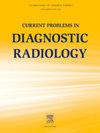临界点:导致泌尿生殖系统和妇科恶性肿瘤治疗发生重大变化的关键肿瘤成像发现。
IF 1.5
Q3 RADIOLOGY, NUCLEAR MEDICINE & MEDICAL IMAGING
引用次数: 0
摘要
目的:本文旨在回顾常见泌尿生殖系统和妇科恶性肿瘤(包括肾细胞癌、膀胱癌以及宫颈癌、子宫内膜癌和卵巢癌)的分期系统,并强调可能会改变基于放射学分期的患者管理算法的关键影像学发现("临界点"):结论:常见的泌尿生殖系统和妇科恶性肿瘤有一些可识别的影像学特征,包括原发肿瘤的大小、肿瘤的扩展、邻近结构的侵犯、淋巴结受累和远处转移,这些特征提供了重要的预后信息,并决定了患者的治疗方法。放射医师在解释分期检查时必须了解这些成像结果("临界点")。本文章由计算机程序翻译,如有差异,请以英文原文为准。
The tipping point: Key oncologic imaging findings resulting in critical changes in the management of malignant genitourinary and gynecological tumors
Objective
The purpose of this article is to review the staging systems for common malignant genitourinary and gynecological tumors, including renal cell carcinoma, urinary bladder carcinoma, as well as cervical, endometrial, and ovarian carcinoma, and to highlight the key imaging findings (“tipping points”) that may alter patient management algorithms based on radiological staging.
Conclusion
There are identifiable imaging features for the common genitourinary and gynecological malignancies, including the size of the primary tumor, tumor extension, invasion of adjacent structures, lymph node involvement, and distant metastasis, which provide important prognostic information and determine patient management. Radiologists must be aware of these imaging findings (“tipping points”) when interpreting staging examinations.
求助全文
通过发布文献求助,成功后即可免费获取论文全文。
去求助
来源期刊

Current Problems in Diagnostic Radiology
RADIOLOGY, NUCLEAR MEDICINE & MEDICAL IMAGING-
CiteScore
3.00
自引率
0.00%
发文量
113
审稿时长
46 days
期刊介绍:
Current Problems in Diagnostic Radiology covers important and controversial topics in radiology. Each issue presents important viewpoints from leading radiologists. High-quality reproductions of radiographs, CT scans, MR images, and sonograms clearly depict what is being described in each article. Also included are valuable updates relevant to other areas of practice, such as medical-legal issues or archiving systems. With new multi-topic format and image-intensive style, Current Problems in Diagnostic Radiology offers an outstanding, time-saving investigation into current topics most relevant to radiologists.
 求助内容:
求助内容: 应助结果提醒方式:
应助结果提醒方式:


